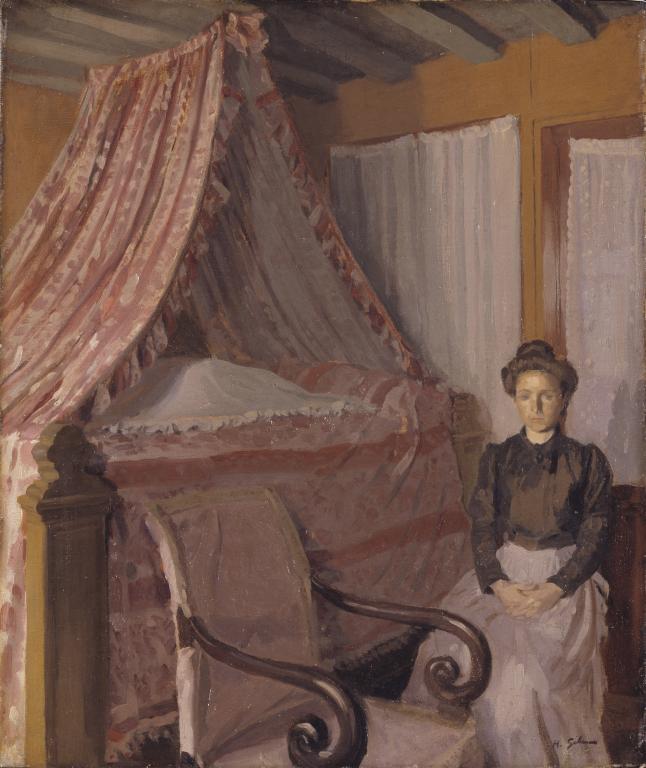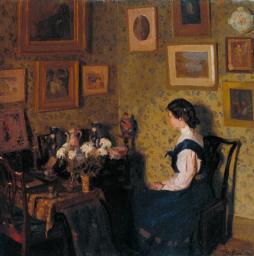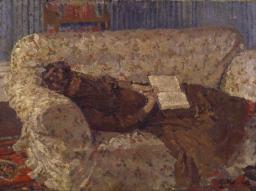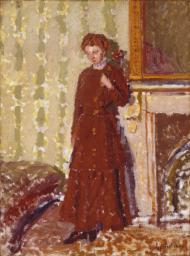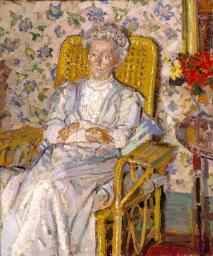Harold Gilman French Interior c.1907
Harold Gilman,
French Interior
c.1907
This painting was given its title in 1919 as the armchair in the foreground and the bed with raised mattress are typically French in style. At the edge of the frame a female figure sits facing the viewer, but it is unclear what she is doing and why. This creates a sense of ambiguity, a common characteristic of Harold Gilman’s interior scenes.
Harold Gilman 1876–1919
French Interior
c.1907
Oil paint on canvas
615 x 520 mm
Inscribed by the artist ‘H. Gilman’ bottom right and ‘No 2 Interior, H Gilman, [...]gate Road, England’ in ink on label on back
Purchased (Benson Fund) 1947
N05783
c.1907
Oil paint on canvas
615 x 520 mm
Inscribed by the artist ‘H. Gilman’ bottom right and ‘No 2 Interior, H Gilman, [...]gate Road, England’ in ink on label on back
Purchased (Benson Fund) 1947
N05783
Ownership history
Purchased from Mrs Sylvia Gilman, the artist’s widow, by Alex, Reid and Lefevre, London, 1944, by whom sold to Mrs E.M. Macdonald (wife of Duncan Macdonald, Director of Alex, Reid and Lefevre) the same year, from whom bought by Tate Gallery 1947.
Exhibition history
1919
Memorial Exhibition of Works by the Late Harold Gilman, Leicester Galleries, London, October 1919 (3, as ‘A French interior (an early work)’).
1945
The One Hundred and Nineteenth Exhibition of the Royal Scottish Academy of Painting, Sculpture, and Architecture, Royal Scottish Academy, Edinburgh, 1945 (127).
1947
Sickert to Hodgkins, Lefevre Gallery, London, August 1947 (10).
1954–5
Harold Gilman 1876–1919, (Arts Council tour), Arts Council, London, January–December 1954, Manchester Art Gallery, November–December 1954, Tate Gallery, London, May–June 1955 (6).
1987–92
Government Art Collection, 10 Downing Street, July 1987–July 1992 (long loan).
1992–5
Government Art Collection, October 1992–August 1995 (long loan).
References
1952
John Rothenstein, Modern English Painters: Sickert to Smith, London 1952, p.154, reproduced as The Little French Girl.
1964
Mary Chamot, Dennis Farr and Martin Butlin, Tate Gallery Catalogues: The Modern British Paintings, Drawings and Sculpture, vol.1, London 1964, p.236.
2000
Wendy Baron, Perfect Moderns: A History of the Camden Town Group, Aldershot and Vermont 2000, p.169.
Technique and condition
French Interior is painted on commercially primed canvas in artists’ oil paint. A historic paper label on the back bears an ink inscription in Gilman’s hand. The label is damaged but parts of it are still legible and read: ‘No 2 Interior, H Gilman, [...]gate Road, England’.
The prepared canvas conforms to the basic type found on all of Gilman’s paintings in the Tate collection (see also Tate T00096). It is fine plain weave linen and retains its selvedge. The canvas is sized and has a single white priming. The priming extends to the cut edges of the canvas and retains the fine weave texture. It has penetrated through to the back of the canvas in places, indicating that the sizing may be very thin and discontinuous. There are double pin holes with the remnants of steel prongs at each corner applied through the painted canvas. These may have been made by pins used to locate the canvas for re-stretching. The work was put onto its existing stretcher some time after painting, possibly when the picture was varnished, and the studio stamp subsequently applied.
There are evenly spaced pin holes along all four edges of the painted surface that may relate to a threaded grid for the transfer of a drawn image, although there is no visible evidence of any graphic underdrawing. The initial composition was established with freely drawn and washed areas of colours in thinned paint. After the painting had been laid in with a limited range of pinks, greys and browns, it was allowed to become touch-dry before applying the main colouring. This tonal underpainting remains visible in many areas around the borders of forms. The final colouring and details were applied with fluent strokes of medium-rich paint that flowed easily across the fine texture retaining some softened brushmarking. There is little sign of hesitation or revision apart from some areas of particular focus, such as the figure. Fresh, wet-in-wet touches evoke the play of light on different surfaces, such as the translucent net curtains and satin-like shimmer of the bed clothes. The drawing is occasionally reinstated during the final painting as in the fall of the bed drapes.
Roy Perry and Sarah Morgan
August 2004
How to cite
Roy Perry and Sarah Morgan, 'Technique and Condition', August 2004, in Robert Upstone, ‘French Interior c.1907 by Harold Gilman’, catalogue entry, May 2009, in Helena Bonett, Ysanne Holt, Jennifer Mundy (eds.), The Camden Town Group in Context, Tate Research Publication, May 2012, https://wwwEntry
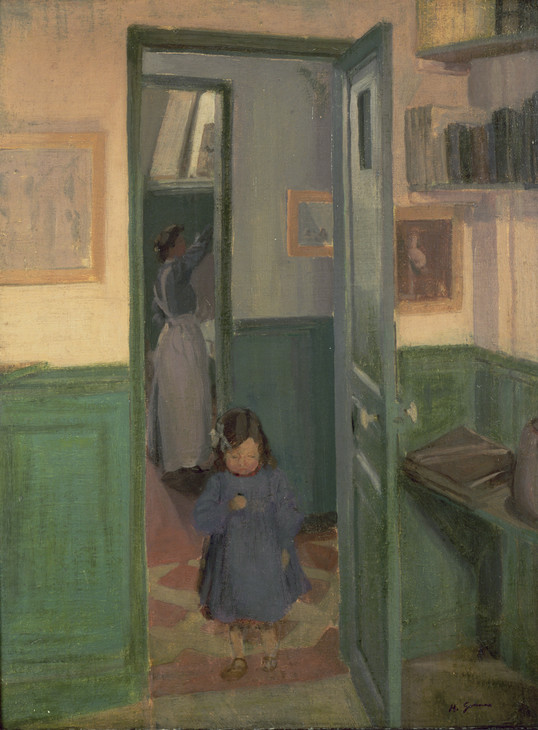
Harold Gilman 1876–1919
In Sickert’s House at Neuville 1907
Oil paint on canvas
587 x 457 mm
Leeds Museums and Galleries (City Art Gallery)
Photo © Leeds Museums and Galleries (City Art Gallery) UK / The Bridgeman Art Library
Fig.1
Harold Gilman
In Sickert’s House at Neuville 1907
Leeds Museums and Galleries (City Art Gallery)
Photo © Leeds Museums and Galleries (City Art Gallery) UK / The Bridgeman Art Library
Around the time he made French Interior, Gilman painted a number of pictures of interiors, usually of houses in which he lived. Here the composition is tightly constrained, the picture space pushing all the elements together to create a mixture of intimacy and claustrophobia. It is possible that Gilman was using some sort of proportional composition formula. The woman remains unidentified. She is not Gilman’s wife Grace, nor apparently their maid Susan who appears in pictures such as Interior 1908 (private collection);4 neither does she appear to be Sickert’s housekeeper in France.
However decorously dressed and modest, the picture was likely to have raised questions for an Edwardian audience about the probity of showing a woman in her – or the artist’s – bedroom. The sitter’s tidy posture, hands folded in her lap, suggests self-containment, and her direct gaze is confident. But there is also a feeling of marked ambiguity about the scene. Fitting into Gilman’s programme of painting scenes of figures in interiors (see Tate T00096 and T13024), it raises questions about why the woman is sitting in the bedroom – is she waiting for someone, or simply observing the painter observing her? Why is she doing nothing? Seated against the door, she blocks any exit from the bedroom. What is the purpose – or intention – of a scene that, while a piece of ‘naturalist’ observation, is evidently completely staged? The dominance of the room’s furniture, and the figure’s marginality within the composition, suppress any sense that the picture is a portrait, while the cropping of the foreground makes us feel as if we are in the room with her, in a kind of enforced intimacy.
There is a certain similarity to a painting by William Orpen, The Bedroom (‘The Bed, Cany’) 1900 (private collection),5 which shows Orpen’s fiancée Emily Scobel seated beside a canopied bed. It was only exhibited at the Royal Hibernian Academy in 1901, and so Gilman is perhaps unlikely to have seen it, but it is another example of the type of subjectless interior scene that was popularised in the first decade of the twentieth century. Gilman returned to the theme again in his painting Interior of 1917–18 (British Council),6 which shows his second wife Sylvia sitting on the corner of a bed with her back facing the viewer.
Robert Upstone
May 2009
Related biographies
Related essays
Related catalogue entries
Related reviews and articles
- Harold Gilman, ‘The Venus of Velasquez’ The Art News, 28 April 1910, p.198.
How to cite
Robert Upstone, ‘French Interior c.1907 by Harold Gilman’, catalogue entry, May 2009, in Helena Bonett, Ysanne Holt, Jennifer Mundy (eds.), The Camden Town Group in Context, Tate Research Publication, May 2012, https://www

